HRM Report: Netflix's Learning, Reward & Performance Strategies
VerifiedAdded on 2023/01/12
|11
|2665
|88
Report
AI Summary
This report provides an in-depth analysis of Netflix's Human Resource Management (HRM) strategies, focusing on learning, development, training, reward, and performance management. It begins by differentiating between learning, training, and development, then examines Netflix's unique training processes, including gamification, and the benefits of these practices, such as enhanced productivity and employee motivation. The report then explores Netflix's reward and performance management systems, highlighting the concepts of intrinsic and extrinsic rewards and the 'context, not control' approach to performance management, including the use of 360-degree feedback. The significance of these strategies to Netflix is discussed, emphasizing increased productivity, employee retention, and the alignment of employee objectives with organizational goals. The report concludes by summarizing the key findings and emphasizing the importance of Netflix's innovative HRM practices in its success as a market leader in the digital streaming industry.
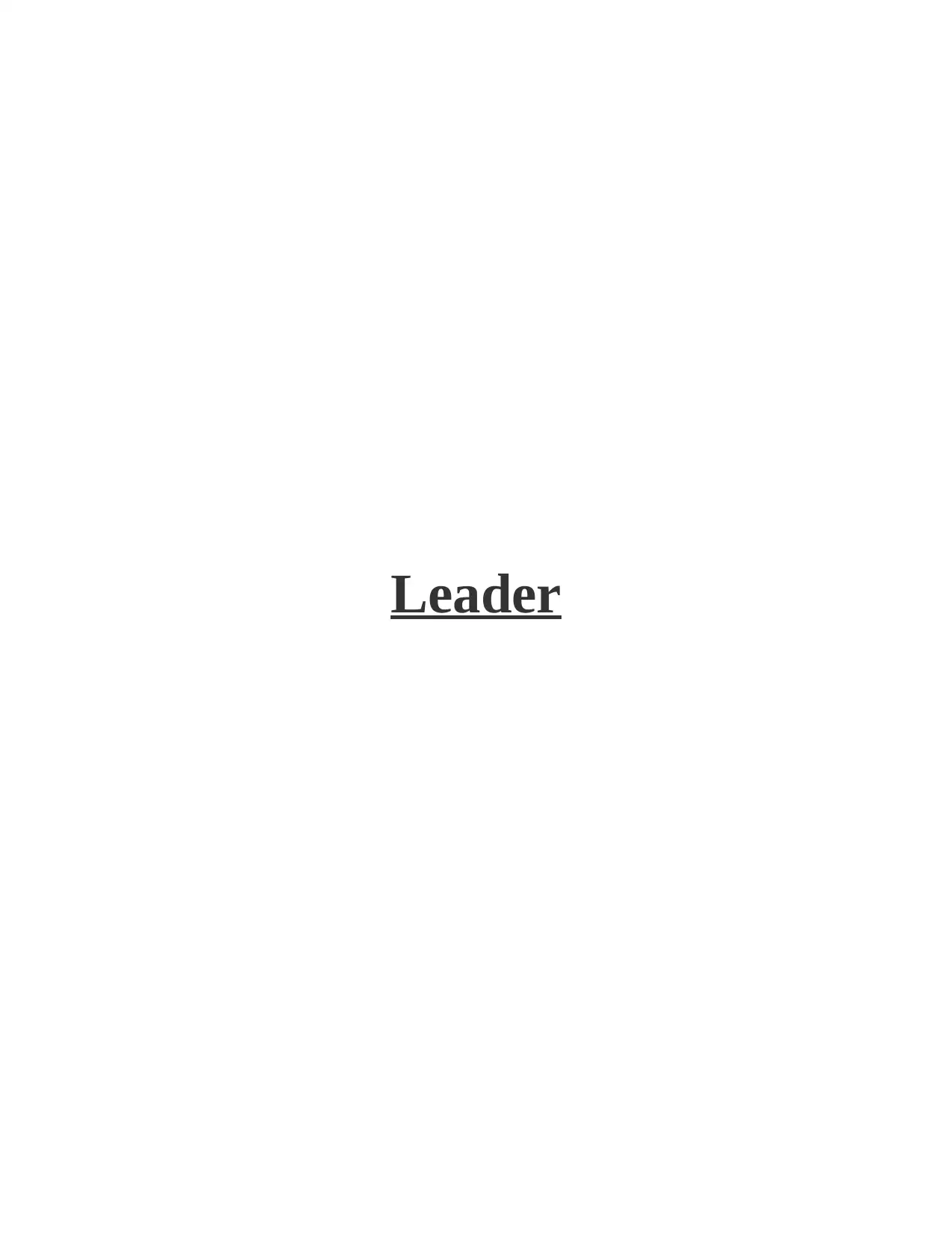
Leader
Paraphrase This Document
Need a fresh take? Get an instant paraphrase of this document with our AI Paraphraser
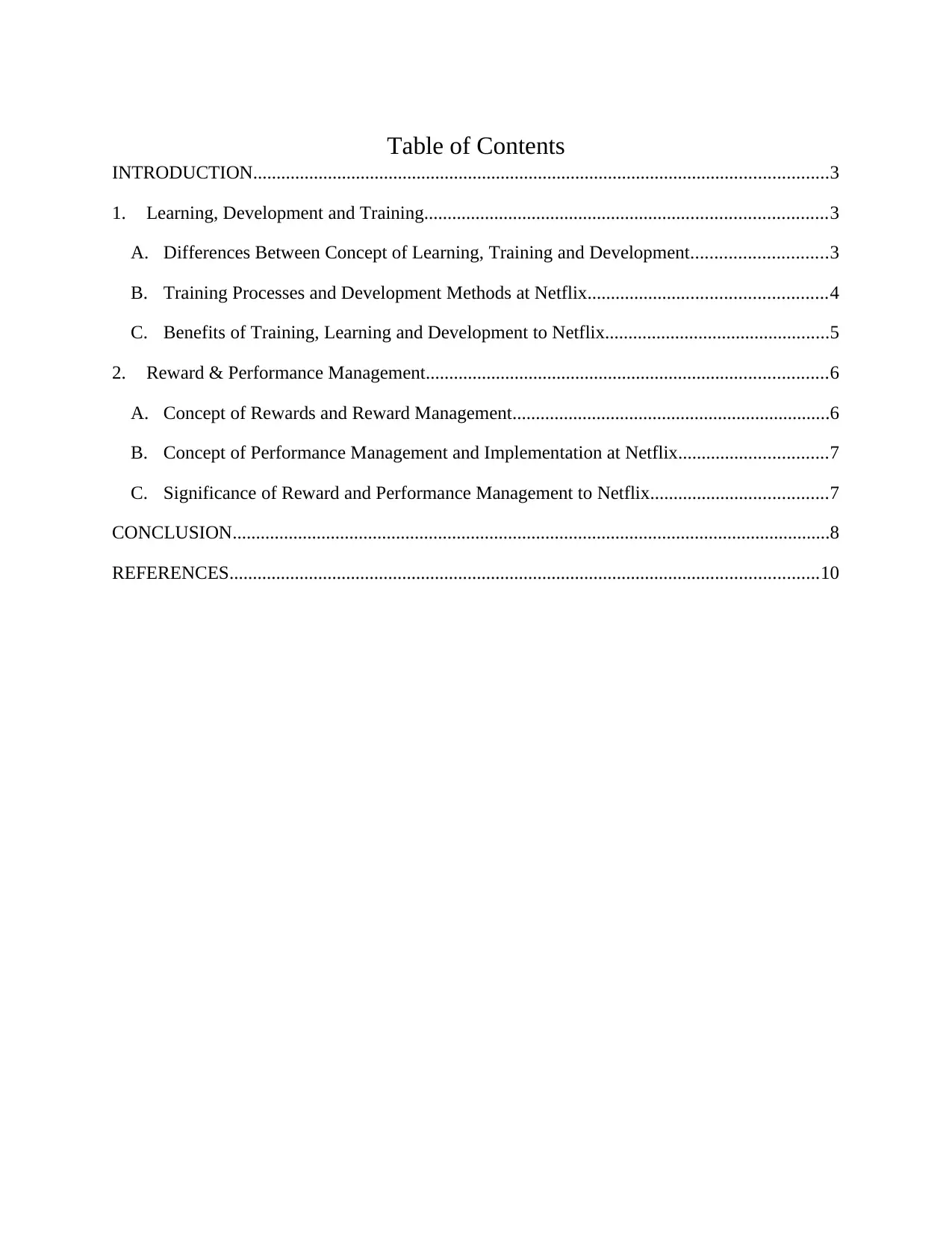
Table of Contents
INTRODUCTION...........................................................................................................................3
1. Learning, Development and Training......................................................................................3
A. Differences Between Concept of Learning, Training and Development.............................3
B. Training Processes and Development Methods at Netflix...................................................4
C. Benefits of Training, Learning and Development to Netflix................................................5
2. Reward & Performance Management......................................................................................6
A. Concept of Rewards and Reward Management....................................................................6
B. Concept of Performance Management and Implementation at Netflix................................7
C. Significance of Reward and Performance Management to Netflix......................................7
CONCLUSION................................................................................................................................8
REFERENCES..............................................................................................................................10
INTRODUCTION...........................................................................................................................3
1. Learning, Development and Training......................................................................................3
A. Differences Between Concept of Learning, Training and Development.............................3
B. Training Processes and Development Methods at Netflix...................................................4
C. Benefits of Training, Learning and Development to Netflix................................................5
2. Reward & Performance Management......................................................................................6
A. Concept of Rewards and Reward Management....................................................................6
B. Concept of Performance Management and Implementation at Netflix................................7
C. Significance of Reward and Performance Management to Netflix......................................7
CONCLUSION................................................................................................................................8
REFERENCES..............................................................................................................................10
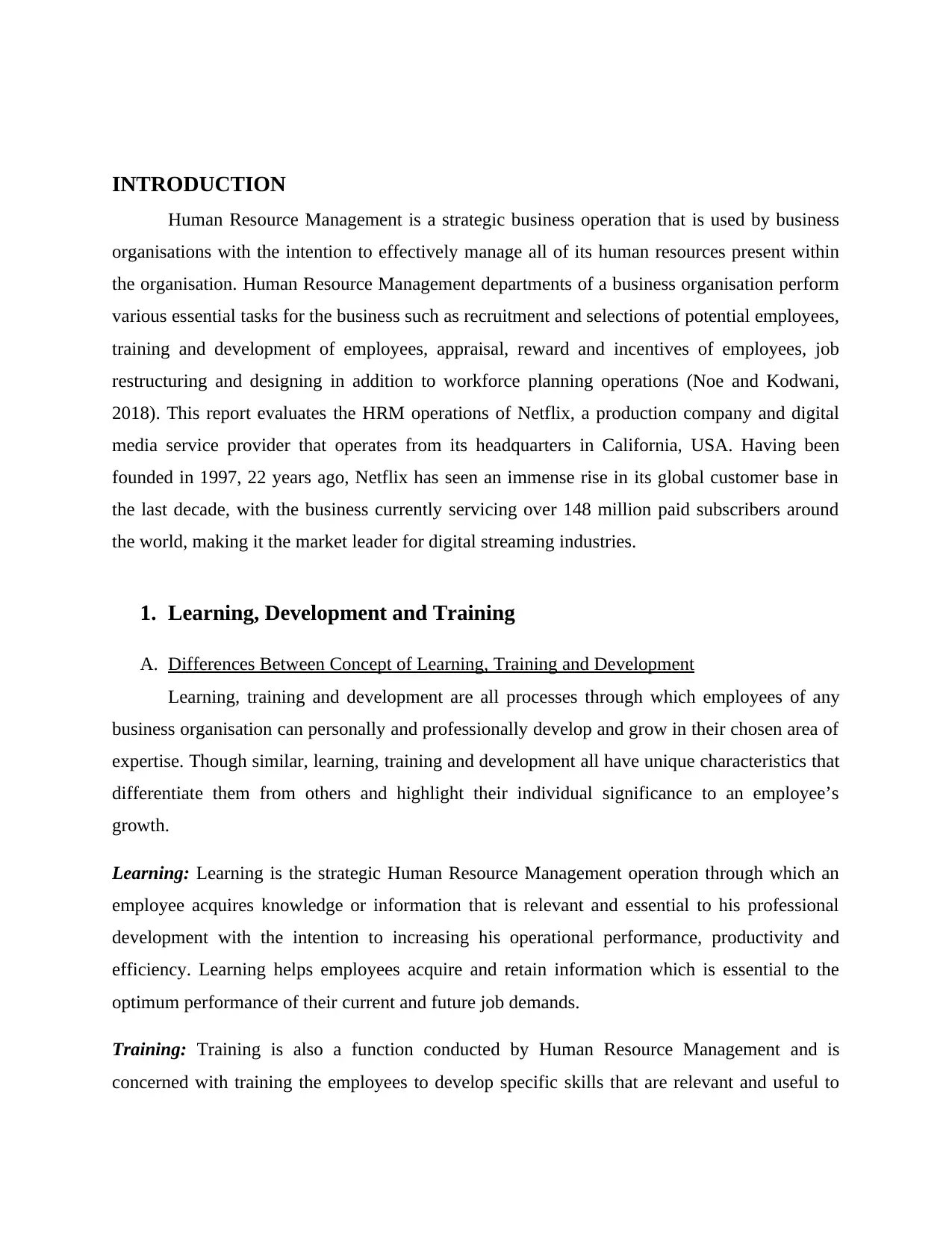
INTRODUCTION
Human Resource Management is a strategic business operation that is used by business
organisations with the intention to effectively manage all of its human resources present within
the organisation. Human Resource Management departments of a business organisation perform
various essential tasks for the business such as recruitment and selections of potential employees,
training and development of employees, appraisal, reward and incentives of employees, job
restructuring and designing in addition to workforce planning operations (Noe and Kodwani,
2018). This report evaluates the HRM operations of Netflix, a production company and digital
media service provider that operates from its headquarters in California, USA. Having been
founded in 1997, 22 years ago, Netflix has seen an immense rise in its global customer base in
the last decade, with the business currently servicing over 148 million paid subscribers around
the world, making it the market leader for digital streaming industries.
1. Learning, Development and Training
A. Differences Between Concept of Learning, Training and Development
Learning, training and development are all processes through which employees of any
business organisation can personally and professionally develop and grow in their chosen area of
expertise. Though similar, learning, training and development all have unique characteristics that
differentiate them from others and highlight their individual significance to an employee’s
growth.
Learning: Learning is the strategic Human Resource Management operation through which an
employee acquires knowledge or information that is relevant and essential to his professional
development with the intention to increasing his operational performance, productivity and
efficiency. Learning helps employees acquire and retain information which is essential to the
optimum performance of their current and future job demands.
Training: Training is also a function conducted by Human Resource Management and is
concerned with training the employees to develop specific skills that are relevant and useful to
Human Resource Management is a strategic business operation that is used by business
organisations with the intention to effectively manage all of its human resources present within
the organisation. Human Resource Management departments of a business organisation perform
various essential tasks for the business such as recruitment and selections of potential employees,
training and development of employees, appraisal, reward and incentives of employees, job
restructuring and designing in addition to workforce planning operations (Noe and Kodwani,
2018). This report evaluates the HRM operations of Netflix, a production company and digital
media service provider that operates from its headquarters in California, USA. Having been
founded in 1997, 22 years ago, Netflix has seen an immense rise in its global customer base in
the last decade, with the business currently servicing over 148 million paid subscribers around
the world, making it the market leader for digital streaming industries.
1. Learning, Development and Training
A. Differences Between Concept of Learning, Training and Development
Learning, training and development are all processes through which employees of any
business organisation can personally and professionally develop and grow in their chosen area of
expertise. Though similar, learning, training and development all have unique characteristics that
differentiate them from others and highlight their individual significance to an employee’s
growth.
Learning: Learning is the strategic Human Resource Management operation through which an
employee acquires knowledge or information that is relevant and essential to his professional
development with the intention to increasing his operational performance, productivity and
efficiency. Learning helps employees acquire and retain information which is essential to the
optimum performance of their current and future job demands.
Training: Training is also a function conducted by Human Resource Management and is
concerned with training the employees to develop specific skills that are relevant and useful to
⊘ This is a preview!⊘
Do you want full access?
Subscribe today to unlock all pages.

Trusted by 1+ million students worldwide
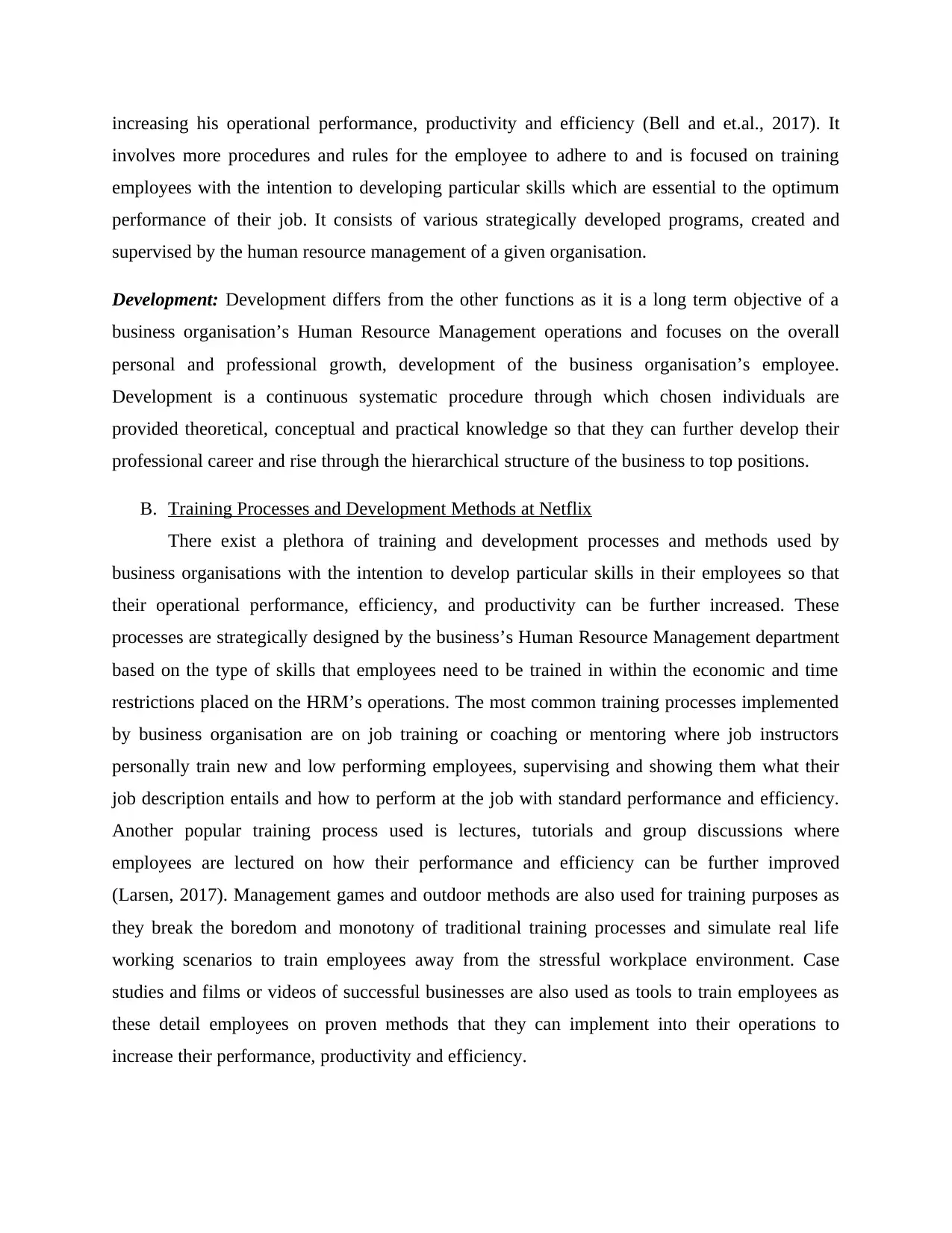
increasing his operational performance, productivity and efficiency (Bell and et.al., 2017). It
involves more procedures and rules for the employee to adhere to and is focused on training
employees with the intention to developing particular skills which are essential to the optimum
performance of their job. It consists of various strategically developed programs, created and
supervised by the human resource management of a given organisation.
Development: Development differs from the other functions as it is a long term objective of a
business organisation’s Human Resource Management operations and focuses on the overall
personal and professional growth, development of the business organisation’s employee.
Development is a continuous systematic procedure through which chosen individuals are
provided theoretical, conceptual and practical knowledge so that they can further develop their
professional career and rise through the hierarchical structure of the business to top positions.
B. Training Processes and Development Methods at Netflix
There exist a plethora of training and development processes and methods used by
business organisations with the intention to develop particular skills in their employees so that
their operational performance, efficiency, and productivity can be further increased. These
processes are strategically designed by the business’s Human Resource Management department
based on the type of skills that employees need to be trained in within the economic and time
restrictions placed on the HRM’s operations. The most common training processes implemented
by business organisation are on job training or coaching or mentoring where job instructors
personally train new and low performing employees, supervising and showing them what their
job description entails and how to perform at the job with standard performance and efficiency.
Another popular training process used is lectures, tutorials and group discussions where
employees are lectured on how their performance and efficiency can be further improved
(Larsen, 2017). Management games and outdoor methods are also used for training purposes as
they break the boredom and monotony of traditional training processes and simulate real life
working scenarios to train employees away from the stressful workplace environment. Case
studies and films or videos of successful businesses are also used as tools to train employees as
these detail employees on proven methods that they can implement into their operations to
increase their performance, productivity and efficiency.
involves more procedures and rules for the employee to adhere to and is focused on training
employees with the intention to developing particular skills which are essential to the optimum
performance of their job. It consists of various strategically developed programs, created and
supervised by the human resource management of a given organisation.
Development: Development differs from the other functions as it is a long term objective of a
business organisation’s Human Resource Management operations and focuses on the overall
personal and professional growth, development of the business organisation’s employee.
Development is a continuous systematic procedure through which chosen individuals are
provided theoretical, conceptual and practical knowledge so that they can further develop their
professional career and rise through the hierarchical structure of the business to top positions.
B. Training Processes and Development Methods at Netflix
There exist a plethora of training and development processes and methods used by
business organisations with the intention to develop particular skills in their employees so that
their operational performance, efficiency, and productivity can be further increased. These
processes are strategically designed by the business’s Human Resource Management department
based on the type of skills that employees need to be trained in within the economic and time
restrictions placed on the HRM’s operations. The most common training processes implemented
by business organisation are on job training or coaching or mentoring where job instructors
personally train new and low performing employees, supervising and showing them what their
job description entails and how to perform at the job with standard performance and efficiency.
Another popular training process used is lectures, tutorials and group discussions where
employees are lectured on how their performance and efficiency can be further improved
(Larsen, 2017). Management games and outdoor methods are also used for training purposes as
they break the boredom and monotony of traditional training processes and simulate real life
working scenarios to train employees away from the stressful workplace environment. Case
studies and films or videos of successful businesses are also used as tools to train employees as
these detail employees on proven methods that they can implement into their operations to
increase their performance, productivity and efficiency.
Paraphrase This Document
Need a fresh take? Get an instant paraphrase of this document with our AI Paraphraser
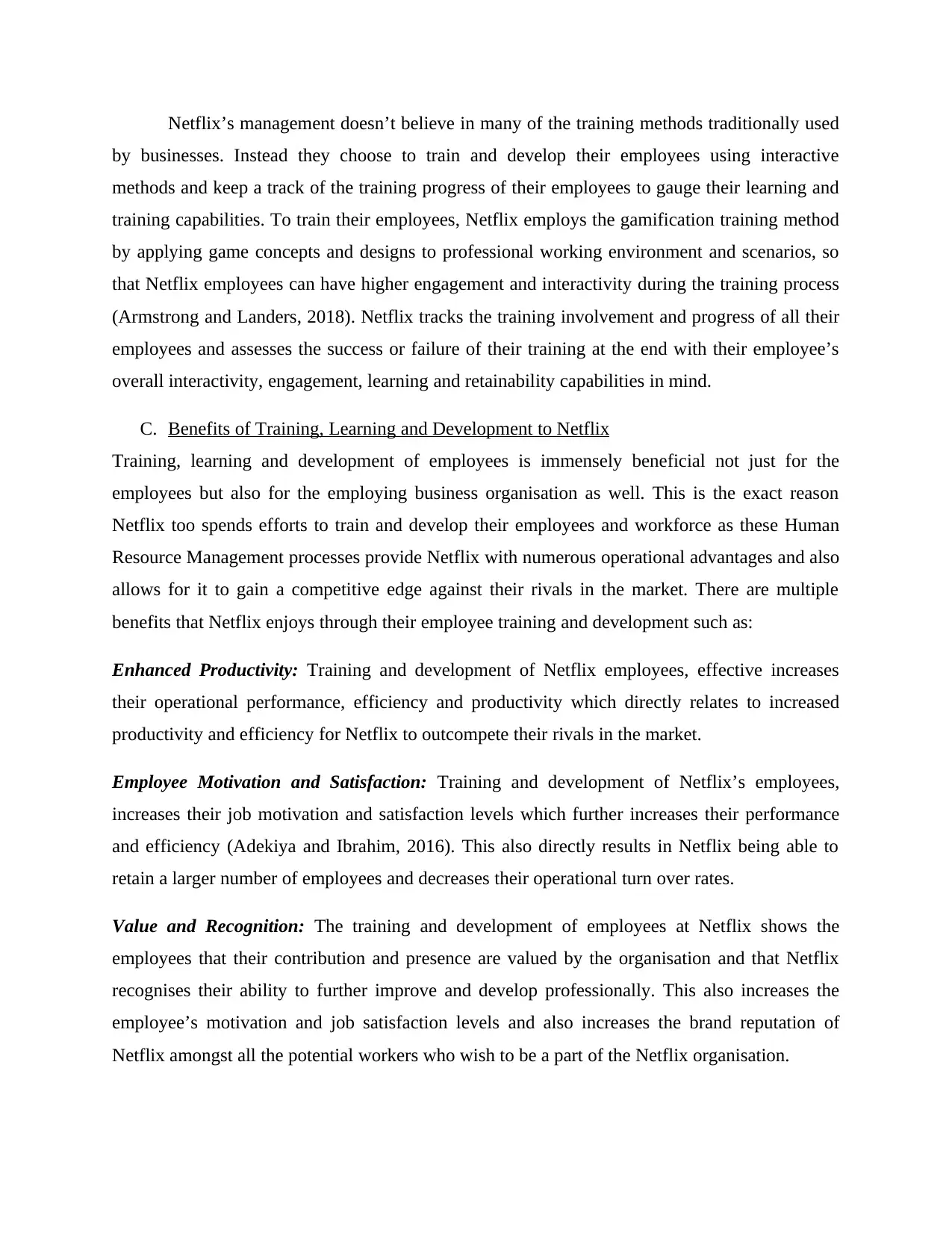
Netflix’s management doesn’t believe in many of the training methods traditionally used
by businesses. Instead they choose to train and develop their employees using interactive
methods and keep a track of the training progress of their employees to gauge their learning and
training capabilities. To train their employees, Netflix employs the gamification training method
by applying game concepts and designs to professional working environment and scenarios, so
that Netflix employees can have higher engagement and interactivity during the training process
(Armstrong and Landers, 2018). Netflix tracks the training involvement and progress of all their
employees and assesses the success or failure of their training at the end with their employee’s
overall interactivity, engagement, learning and retainability capabilities in mind.
C. Benefits of Training, Learning and Development to Netflix
Training, learning and development of employees is immensely beneficial not just for the
employees but also for the employing business organisation as well. This is the exact reason
Netflix too spends efforts to train and develop their employees and workforce as these Human
Resource Management processes provide Netflix with numerous operational advantages and also
allows for it to gain a competitive edge against their rivals in the market. There are multiple
benefits that Netflix enjoys through their employee training and development such as:
Enhanced Productivity: Training and development of Netflix employees, effective increases
their operational performance, efficiency and productivity which directly relates to increased
productivity and efficiency for Netflix to outcompete their rivals in the market.
Employee Motivation and Satisfaction: Training and development of Netflix’s employees,
increases their job motivation and satisfaction levels which further increases their performance
and efficiency (Adekiya and Ibrahim, 2016). This also directly results in Netflix being able to
retain a larger number of employees and decreases their operational turn over rates.
Value and Recognition: The training and development of employees at Netflix shows the
employees that their contribution and presence are valued by the organisation and that Netflix
recognises their ability to further improve and develop professionally. This also increases the
employee’s motivation and job satisfaction levels and also increases the brand reputation of
Netflix amongst all the potential workers who wish to be a part of the Netflix organisation.
by businesses. Instead they choose to train and develop their employees using interactive
methods and keep a track of the training progress of their employees to gauge their learning and
training capabilities. To train their employees, Netflix employs the gamification training method
by applying game concepts and designs to professional working environment and scenarios, so
that Netflix employees can have higher engagement and interactivity during the training process
(Armstrong and Landers, 2018). Netflix tracks the training involvement and progress of all their
employees and assesses the success or failure of their training at the end with their employee’s
overall interactivity, engagement, learning and retainability capabilities in mind.
C. Benefits of Training, Learning and Development to Netflix
Training, learning and development of employees is immensely beneficial not just for the
employees but also for the employing business organisation as well. This is the exact reason
Netflix too spends efforts to train and develop their employees and workforce as these Human
Resource Management processes provide Netflix with numerous operational advantages and also
allows for it to gain a competitive edge against their rivals in the market. There are multiple
benefits that Netflix enjoys through their employee training and development such as:
Enhanced Productivity: Training and development of Netflix employees, effective increases
their operational performance, efficiency and productivity which directly relates to increased
productivity and efficiency for Netflix to outcompete their rivals in the market.
Employee Motivation and Satisfaction: Training and development of Netflix’s employees,
increases their job motivation and satisfaction levels which further increases their performance
and efficiency (Adekiya and Ibrahim, 2016). This also directly results in Netflix being able to
retain a larger number of employees and decreases their operational turn over rates.
Value and Recognition: The training and development of employees at Netflix shows the
employees that their contribution and presence are valued by the organisation and that Netflix
recognises their ability to further improve and develop professionally. This also increases the
employee’s motivation and job satisfaction levels and also increases the brand reputation of
Netflix amongst all the potential workers who wish to be a part of the Netflix organisation.
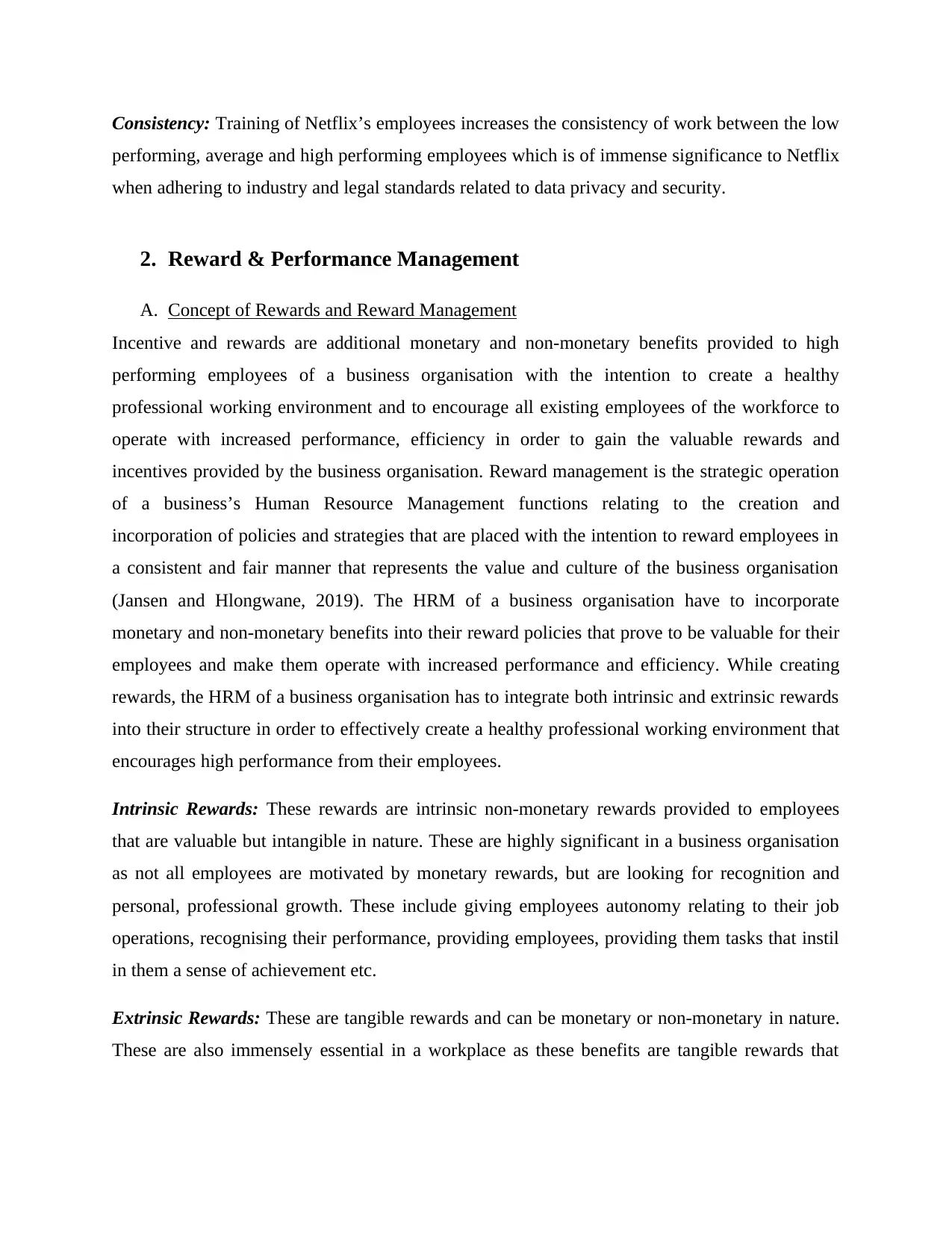
Consistency: Training of Netflix’s employees increases the consistency of work between the low
performing, average and high performing employees which is of immense significance to Netflix
when adhering to industry and legal standards related to data privacy and security.
2. Reward & Performance Management
A. Concept of Rewards and Reward Management
Incentive and rewards are additional monetary and non-monetary benefits provided to high
performing employees of a business organisation with the intention to create a healthy
professional working environment and to encourage all existing employees of the workforce to
operate with increased performance, efficiency in order to gain the valuable rewards and
incentives provided by the business organisation. Reward management is the strategic operation
of a business’s Human Resource Management functions relating to the creation and
incorporation of policies and strategies that are placed with the intention to reward employees in
a consistent and fair manner that represents the value and culture of the business organisation
(Jansen and Hlongwane, 2019). The HRM of a business organisation have to incorporate
monetary and non-monetary benefits into their reward policies that prove to be valuable for their
employees and make them operate with increased performance and efficiency. While creating
rewards, the HRM of a business organisation has to integrate both intrinsic and extrinsic rewards
into their structure in order to effectively create a healthy professional working environment that
encourages high performance from their employees.
Intrinsic Rewards: These rewards are intrinsic non-monetary rewards provided to employees
that are valuable but intangible in nature. These are highly significant in a business organisation
as not all employees are motivated by monetary rewards, but are looking for recognition and
personal, professional growth. These include giving employees autonomy relating to their job
operations, recognising their performance, providing employees, providing them tasks that instil
in them a sense of achievement etc.
Extrinsic Rewards: These are tangible rewards and can be monetary or non-monetary in nature.
These are also immensely essential in a workplace as these benefits are tangible rewards that
performing, average and high performing employees which is of immense significance to Netflix
when adhering to industry and legal standards related to data privacy and security.
2. Reward & Performance Management
A. Concept of Rewards and Reward Management
Incentive and rewards are additional monetary and non-monetary benefits provided to high
performing employees of a business organisation with the intention to create a healthy
professional working environment and to encourage all existing employees of the workforce to
operate with increased performance, efficiency in order to gain the valuable rewards and
incentives provided by the business organisation. Reward management is the strategic operation
of a business’s Human Resource Management functions relating to the creation and
incorporation of policies and strategies that are placed with the intention to reward employees in
a consistent and fair manner that represents the value and culture of the business organisation
(Jansen and Hlongwane, 2019). The HRM of a business organisation have to incorporate
monetary and non-monetary benefits into their reward policies that prove to be valuable for their
employees and make them operate with increased performance and efficiency. While creating
rewards, the HRM of a business organisation has to integrate both intrinsic and extrinsic rewards
into their structure in order to effectively create a healthy professional working environment that
encourages high performance from their employees.
Intrinsic Rewards: These rewards are intrinsic non-monetary rewards provided to employees
that are valuable but intangible in nature. These are highly significant in a business organisation
as not all employees are motivated by monetary rewards, but are looking for recognition and
personal, professional growth. These include giving employees autonomy relating to their job
operations, recognising their performance, providing employees, providing them tasks that instil
in them a sense of achievement etc.
Extrinsic Rewards: These are tangible rewards and can be monetary or non-monetary in nature.
These are also immensely essential in a workplace as these benefits are tangible rewards that
⊘ This is a preview!⊘
Do you want full access?
Subscribe today to unlock all pages.

Trusted by 1+ million students worldwide
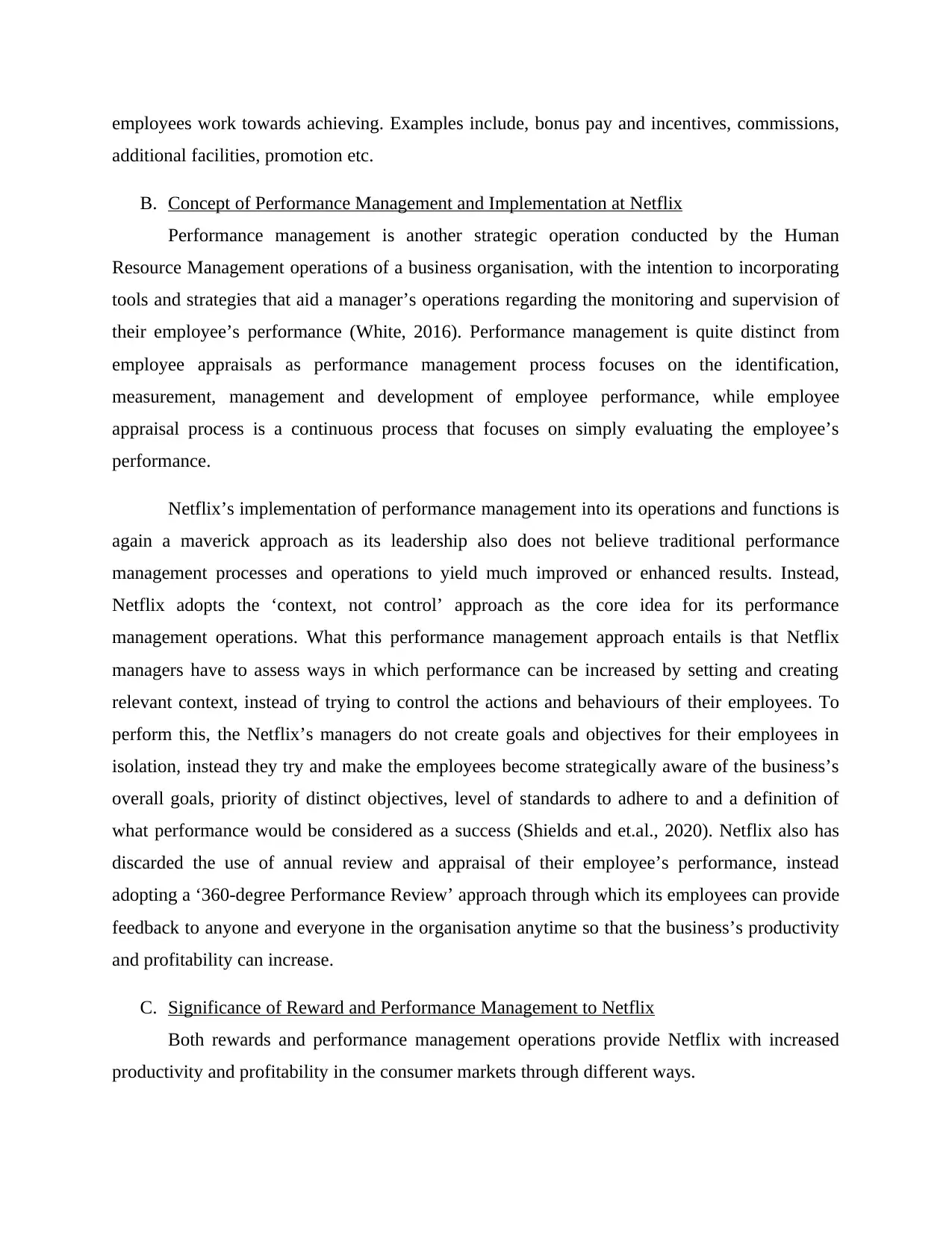
employees work towards achieving. Examples include, bonus pay and incentives, commissions,
additional facilities, promotion etc.
B. Concept of Performance Management and Implementation at Netflix
Performance management is another strategic operation conducted by the Human
Resource Management operations of a business organisation, with the intention to incorporating
tools and strategies that aid a manager’s operations regarding the monitoring and supervision of
their employee’s performance (White, 2016). Performance management is quite distinct from
employee appraisals as performance management process focuses on the identification,
measurement, management and development of employee performance, while employee
appraisal process is a continuous process that focuses on simply evaluating the employee’s
performance.
Netflix’s implementation of performance management into its operations and functions is
again a maverick approach as its leadership also does not believe traditional performance
management processes and operations to yield much improved or enhanced results. Instead,
Netflix adopts the ‘context, not control’ approach as the core idea for its performance
management operations. What this performance management approach entails is that Netflix
managers have to assess ways in which performance can be increased by setting and creating
relevant context, instead of trying to control the actions and behaviours of their employees. To
perform this, the Netflix’s managers do not create goals and objectives for their employees in
isolation, instead they try and make the employees become strategically aware of the business’s
overall goals, priority of distinct objectives, level of standards to adhere to and a definition of
what performance would be considered as a success (Shields and et.al., 2020). Netflix also has
discarded the use of annual review and appraisal of their employee’s performance, instead
adopting a ‘360-degree Performance Review’ approach through which its employees can provide
feedback to anyone and everyone in the organisation anytime so that the business’s productivity
and profitability can increase.
C. Significance of Reward and Performance Management to Netflix
Both rewards and performance management operations provide Netflix with increased
productivity and profitability in the consumer markets through different ways.
additional facilities, promotion etc.
B. Concept of Performance Management and Implementation at Netflix
Performance management is another strategic operation conducted by the Human
Resource Management operations of a business organisation, with the intention to incorporating
tools and strategies that aid a manager’s operations regarding the monitoring and supervision of
their employee’s performance (White, 2016). Performance management is quite distinct from
employee appraisals as performance management process focuses on the identification,
measurement, management and development of employee performance, while employee
appraisal process is a continuous process that focuses on simply evaluating the employee’s
performance.
Netflix’s implementation of performance management into its operations and functions is
again a maverick approach as its leadership also does not believe traditional performance
management processes and operations to yield much improved or enhanced results. Instead,
Netflix adopts the ‘context, not control’ approach as the core idea for its performance
management operations. What this performance management approach entails is that Netflix
managers have to assess ways in which performance can be increased by setting and creating
relevant context, instead of trying to control the actions and behaviours of their employees. To
perform this, the Netflix’s managers do not create goals and objectives for their employees in
isolation, instead they try and make the employees become strategically aware of the business’s
overall goals, priority of distinct objectives, level of standards to adhere to and a definition of
what performance would be considered as a success (Shields and et.al., 2020). Netflix also has
discarded the use of annual review and appraisal of their employee’s performance, instead
adopting a ‘360-degree Performance Review’ approach through which its employees can provide
feedback to anyone and everyone in the organisation anytime so that the business’s productivity
and profitability can increase.
C. Significance of Reward and Performance Management to Netflix
Both rewards and performance management operations provide Netflix with increased
productivity and profitability in the consumer markets through different ways.
Paraphrase This Document
Need a fresh take? Get an instant paraphrase of this document with our AI Paraphraser
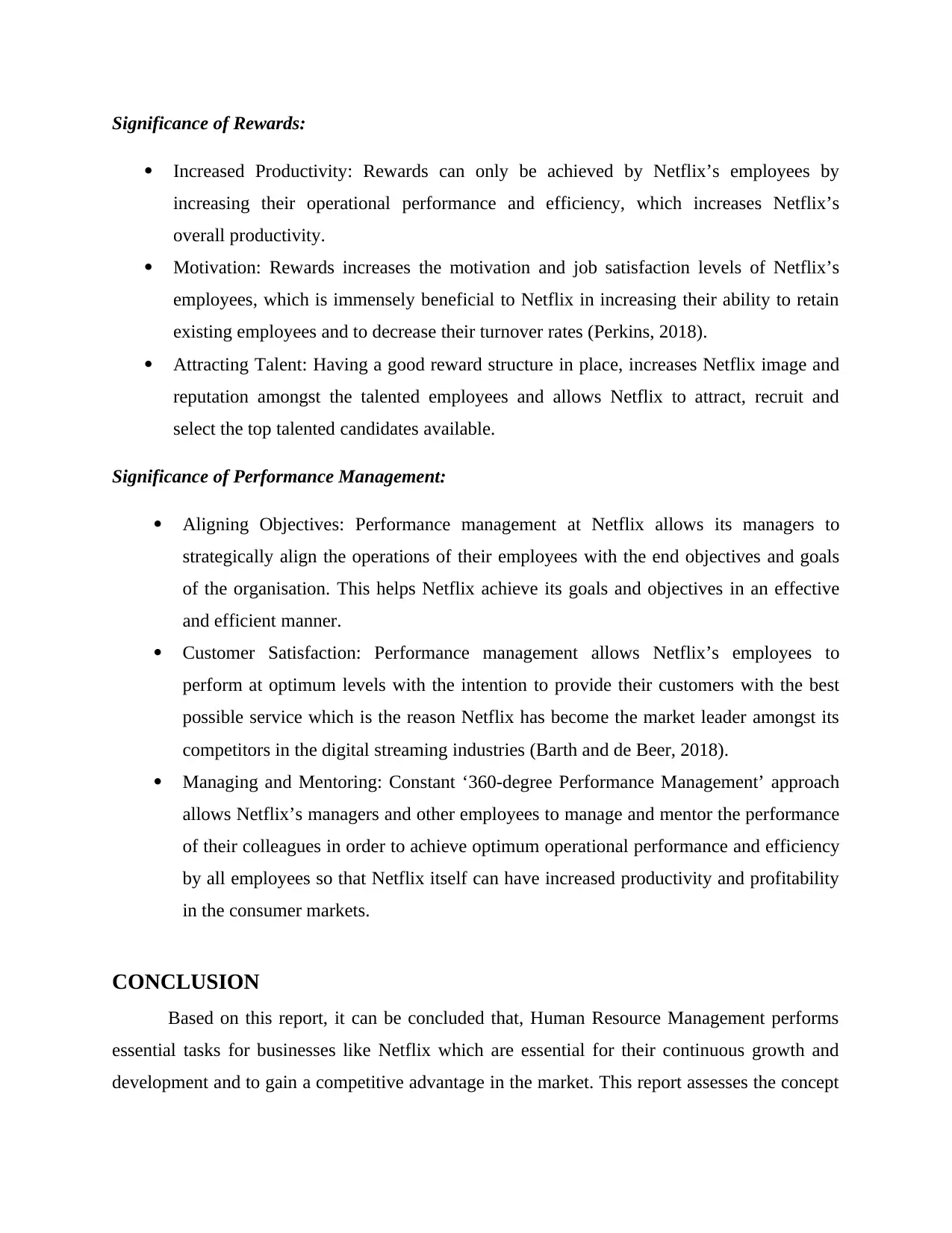
Significance of Rewards:
Increased Productivity: Rewards can only be achieved by Netflix’s employees by
increasing their operational performance and efficiency, which increases Netflix’s
overall productivity.
Motivation: Rewards increases the motivation and job satisfaction levels of Netflix’s
employees, which is immensely beneficial to Netflix in increasing their ability to retain
existing employees and to decrease their turnover rates (Perkins, 2018).
Attracting Talent: Having a good reward structure in place, increases Netflix image and
reputation amongst the talented employees and allows Netflix to attract, recruit and
select the top talented candidates available.
Significance of Performance Management:
Aligning Objectives: Performance management at Netflix allows its managers to
strategically align the operations of their employees with the end objectives and goals
of the organisation. This helps Netflix achieve its goals and objectives in an effective
and efficient manner.
Customer Satisfaction: Performance management allows Netflix’s employees to
perform at optimum levels with the intention to provide their customers with the best
possible service which is the reason Netflix has become the market leader amongst its
competitors in the digital streaming industries (Barth and de Beer, 2018).
Managing and Mentoring: Constant ‘360-degree Performance Management’ approach
allows Netflix’s managers and other employees to manage and mentor the performance
of their colleagues in order to achieve optimum operational performance and efficiency
by all employees so that Netflix itself can have increased productivity and profitability
in the consumer markets.
CONCLUSION
Based on this report, it can be concluded that, Human Resource Management performs
essential tasks for businesses like Netflix which are essential for their continuous growth and
development and to gain a competitive advantage in the market. This report assesses the concept
Increased Productivity: Rewards can only be achieved by Netflix’s employees by
increasing their operational performance and efficiency, which increases Netflix’s
overall productivity.
Motivation: Rewards increases the motivation and job satisfaction levels of Netflix’s
employees, which is immensely beneficial to Netflix in increasing their ability to retain
existing employees and to decrease their turnover rates (Perkins, 2018).
Attracting Talent: Having a good reward structure in place, increases Netflix image and
reputation amongst the talented employees and allows Netflix to attract, recruit and
select the top talented candidates available.
Significance of Performance Management:
Aligning Objectives: Performance management at Netflix allows its managers to
strategically align the operations of their employees with the end objectives and goals
of the organisation. This helps Netflix achieve its goals and objectives in an effective
and efficient manner.
Customer Satisfaction: Performance management allows Netflix’s employees to
perform at optimum levels with the intention to provide their customers with the best
possible service which is the reason Netflix has become the market leader amongst its
competitors in the digital streaming industries (Barth and de Beer, 2018).
Managing and Mentoring: Constant ‘360-degree Performance Management’ approach
allows Netflix’s managers and other employees to manage and mentor the performance
of their colleagues in order to achieve optimum operational performance and efficiency
by all employees so that Netflix itself can have increased productivity and profitability
in the consumer markets.
CONCLUSION
Based on this report, it can be concluded that, Human Resource Management performs
essential tasks for businesses like Netflix which are essential for their continuous growth and
development and to gain a competitive advantage in the market. This report assesses the concept
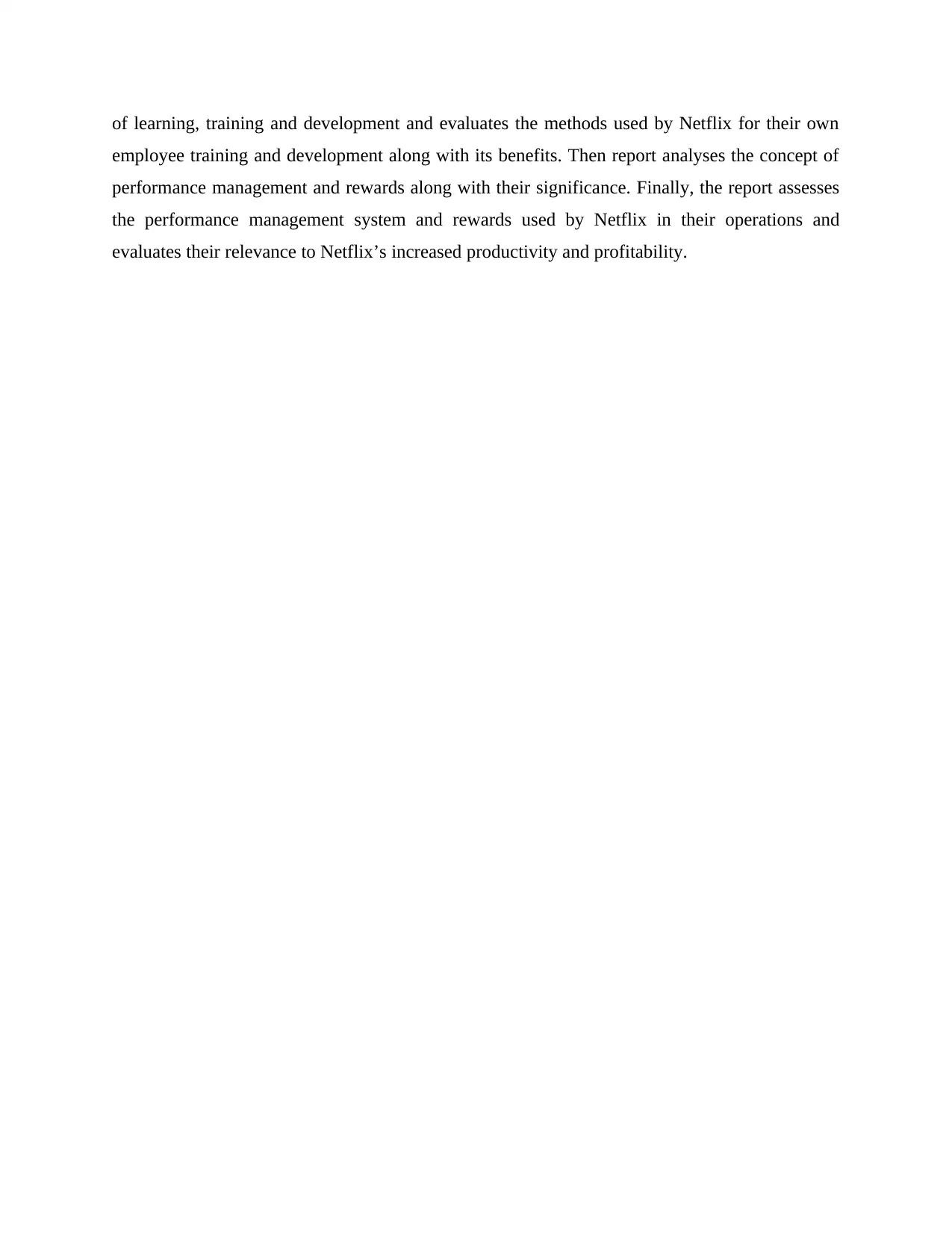
of learning, training and development and evaluates the methods used by Netflix for their own
employee training and development along with its benefits. Then report analyses the concept of
performance management and rewards along with their significance. Finally, the report assesses
the performance management system and rewards used by Netflix in their operations and
evaluates their relevance to Netflix’s increased productivity and profitability.
employee training and development along with its benefits. Then report analyses the concept of
performance management and rewards along with their significance. Finally, the report assesses
the performance management system and rewards used by Netflix in their operations and
evaluates their relevance to Netflix’s increased productivity and profitability.
⊘ This is a preview!⊘
Do you want full access?
Subscribe today to unlock all pages.

Trusted by 1+ million students worldwide
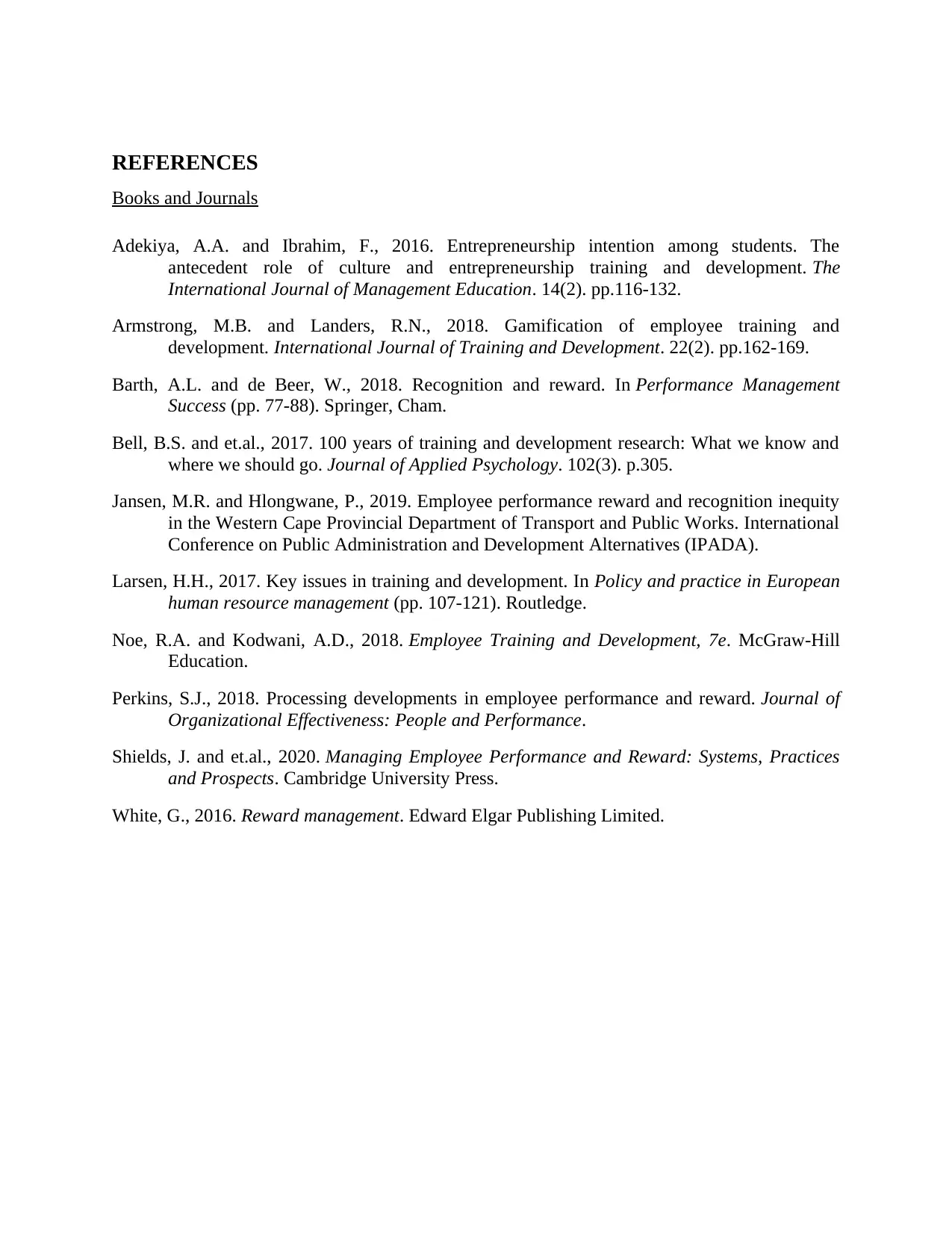
REFERENCES
Books and Journals
Adekiya, A.A. and Ibrahim, F., 2016. Entrepreneurship intention among students. The
antecedent role of culture and entrepreneurship training and development. The
International Journal of Management Education. 14(2). pp.116-132.
Armstrong, M.B. and Landers, R.N., 2018. Gamification of employee training and
development. International Journal of Training and Development. 22(2). pp.162-169.
Barth, A.L. and de Beer, W., 2018. Recognition and reward. In Performance Management
Success (pp. 77-88). Springer, Cham.
Bell, B.S. and et.al., 2017. 100 years of training and development research: What we know and
where we should go. Journal of Applied Psychology. 102(3). p.305.
Jansen, M.R. and Hlongwane, P., 2019. Employee performance reward and recognition inequity
in the Western Cape Provincial Department of Transport and Public Works. International
Conference on Public Administration and Development Alternatives (IPADA).
Larsen, H.H., 2017. Key issues in training and development. In Policy and practice in European
human resource management (pp. 107-121). Routledge.
Noe, R.A. and Kodwani, A.D., 2018. Employee Training and Development, 7e. McGraw-Hill
Education.
Perkins, S.J., 2018. Processing developments in employee performance and reward. Journal of
Organizational Effectiveness: People and Performance.
Shields, J. and et.al., 2020. Managing Employee Performance and Reward: Systems, Practices
and Prospects. Cambridge University Press.
White, G., 2016. Reward management. Edward Elgar Publishing Limited.
Books and Journals
Adekiya, A.A. and Ibrahim, F., 2016. Entrepreneurship intention among students. The
antecedent role of culture and entrepreneurship training and development. The
International Journal of Management Education. 14(2). pp.116-132.
Armstrong, M.B. and Landers, R.N., 2018. Gamification of employee training and
development. International Journal of Training and Development. 22(2). pp.162-169.
Barth, A.L. and de Beer, W., 2018. Recognition and reward. In Performance Management
Success (pp. 77-88). Springer, Cham.
Bell, B.S. and et.al., 2017. 100 years of training and development research: What we know and
where we should go. Journal of Applied Psychology. 102(3). p.305.
Jansen, M.R. and Hlongwane, P., 2019. Employee performance reward and recognition inequity
in the Western Cape Provincial Department of Transport and Public Works. International
Conference on Public Administration and Development Alternatives (IPADA).
Larsen, H.H., 2017. Key issues in training and development. In Policy and practice in European
human resource management (pp. 107-121). Routledge.
Noe, R.A. and Kodwani, A.D., 2018. Employee Training and Development, 7e. McGraw-Hill
Education.
Perkins, S.J., 2018. Processing developments in employee performance and reward. Journal of
Organizational Effectiveness: People and Performance.
Shields, J. and et.al., 2020. Managing Employee Performance and Reward: Systems, Practices
and Prospects. Cambridge University Press.
White, G., 2016. Reward management. Edward Elgar Publishing Limited.
Paraphrase This Document
Need a fresh take? Get an instant paraphrase of this document with our AI Paraphraser

1 out of 11
Related Documents
Your All-in-One AI-Powered Toolkit for Academic Success.
+13062052269
info@desklib.com
Available 24*7 on WhatsApp / Email
![[object Object]](/_next/static/media/star-bottom.7253800d.svg)
Unlock your academic potential
Copyright © 2020–2025 A2Z Services. All Rights Reserved. Developed and managed by ZUCOL.





